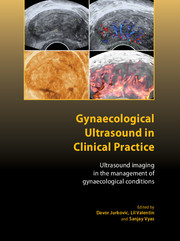 Gynaecological Ultrasound in Clinical Practice
Gynaecological Ultrasound in Clinical Practice Book contents
- Frontmatter
- Contents
- About the authors
- Abbreviations
- Preface
- 1 Ultrasound imaging in gynaecological practice
- 2 Normal pelvic anatomy
- 3 The uterus
- 4 Postmenopausal bleeding: presentation and investigation
- 5 HRT, contraceptives and other drugs affecting the endometrium
- 6 Diagnosis and management of adnexal masses
- 7 Ultrasound assessment of women with pelvic pain
- 8 Ultrasound of non-gynaecological pelvic lesions
- 9 Ultrasound imaging in reproductive medicine
- 10 Ultrasound imaging of the lower urinary tract and uterovaginal prolapse
- 11 Ultrasound and diagnosis of obstetric anal sphincter injuries
- 12 Organisation of the early pregnancy unit
- 13 Sonoembryology: ultrasound examination of early pregnancy
- 14 Diagnosis and management of miscarriage
- 15 Tubal ectopic pregnancy
- 16 Non-tubal ectopic pregnancies
- 17 Ovarian cysts in pregnancy
- Index
6 - Diagnosis and management of adnexal masses
Published online by Cambridge University Press: 05 February 2014
- Frontmatter
- Contents
- About the authors
- Abbreviations
- Preface
- 1 Ultrasound imaging in gynaecological practice
- 2 Normal pelvic anatomy
- 3 The uterus
- 4 Postmenopausal bleeding: presentation and investigation
- 5 HRT, contraceptives and other drugs affecting the endometrium
- 6 Diagnosis and management of adnexal masses
- 7 Ultrasound assessment of women with pelvic pain
- 8 Ultrasound of non-gynaecological pelvic lesions
- 9 Ultrasound imaging in reproductive medicine
- 10 Ultrasound imaging of the lower urinary tract and uterovaginal prolapse
- 11 Ultrasound and diagnosis of obstetric anal sphincter injuries
- 12 Organisation of the early pregnancy unit
- 13 Sonoembryology: ultrasound examination of early pregnancy
- 14 Diagnosis and management of miscarriage
- 15 Tubal ectopic pregnancy
- 16 Non-tubal ectopic pregnancies
- 17 Ovarian cysts in pregnancy
- Index
Summary
Introduction
Transvaginal ultrasound examination is an excellent tool for solving clinical problems in women with symptoms suggesting the presence of an adnexal mass. A gynaecologist experienced in ultrasound diagnosis using good-quality equipment is usually able to establish with confidence the nature of a pelvic tumour from its ultrasound image. This helps to individualise and optimise the management of a woman with a palpable pelvic mass.
Ultrasound morphology for discrimination between benign and malignant adnexal masses
Subjective evaluation of the greyscale ultrasound image (that is, pattern recognition) for discrimination between benign and malignant tumours can be learned by performing gynaecological ultrasound examinations on a regular basis. However, the diagnostic accuracy of subjective assessment of tumour morphology increases with increasing experience. An experienced ultrasound examiner can confidently discriminate between benign and malignant pelvic tumours in the adnexal region using pattern recognition. The reported sensitivity of pattern recognition varies between 88% and 100% and the reported specificity between 62% and 96%. Pattern recognition has been shown to be superior to all other ultrasound methods (such as simple classification systems, scoring systems or mathematical models for calculating the risk of malignancy) for discrimination between benign and malignant extrauterine pelvic masses. Adding Doppler ultrasound examination to subjective evaluation of the greyscale ultrasound image does not seem to yield much improvement in diagnostic precision, but it may increase the confidence with which a correct diagnosis of benignity or malignancy is made.
Keywords
- Type
- Chapter
- Information
- Gynaecological Ultrasound in Clinical PracticeUltrasound Imaging in the Management of Gynaecological Conditions, pp. 55 - 66Publisher: Cambridge University PressPrint publication year: 2009
